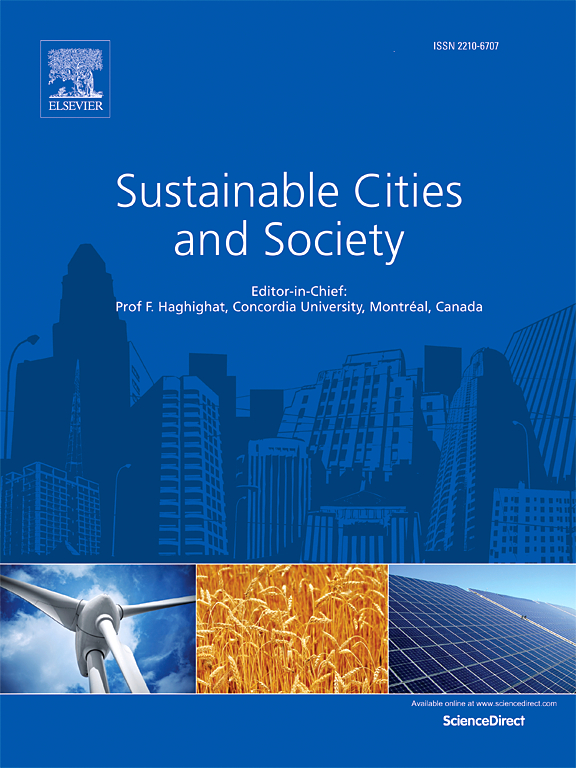Stratified strategies for enhancing thermal comfort through multidimensional compactness optimization in urban built-up areas during heatwaves
IF 10.5
1区 工程技术
Q1 CONSTRUCTION & BUILDING TECHNOLOGY
引用次数: 0
Abstract
Thermal comfort (TC) in built-up areas with varying levels of compactness is unevenly affected during heatwaves (HW). However, identifying zones that should prioritize compactness optimization to effectively enhance TC is often overlooked. This study constructed a research framework for enhancing TC through stratified planning strategies by identifying key compactness-optimized areas and patterns during HW. Taking the built-up area of Shenyang, China, as an example, the compactness index containing spatial, functional and socio-economic dimensions and the TC index were first constructed based on multi-source data. Afterwards, different types of compactness-optimized areas, dominant compactness in different regions, and trade-off and synergy patterns among various dimensions of compactness were revealed using a geographically weighted regression model (GWRM) and local bivariate spatial autocorrelation analysis. The results show that compactness decreases from the center to the periphery of the built-up area, while TC follows the opposite trend. A total of 10 types of compactness-optimized areas are identified, including 8 key types covering 40.472 % of the built-up area. Based on the trade-offs and synergies between different compactness dimensions, 8 optimization patterns are revealed, with synergistic optimization across all three dimensions representing the largest share (71.256 %). Furthermore, 4 optimization categories with different priorities are identified, each exhibiting distinct spatial patterns and targeted optimization strategies. These findings support hierarchical resource allocation and strategic intervention to enhance thermal comfort and promote climate-resilient cities.
热浪期间城市建成区通过多维紧凑性优化来增强热舒适的分层策略
在不同密实度的建成区,热舒适(TC)在热浪(HW)期间受到的影响不均匀。然而,确定应该优先考虑紧凑性优化以有效增强TC的区域经常被忽视。本研究通过确定城市规划过程中紧凑性优化的关键区域和模式,构建了通过分层规划策略提高城市承载力的研究框架。以中国沈阳市建成区为例,首先基于多源数据构建了包含空间、功能和社会经济维度的紧凑度指数和TC指数。随后,利用地理加权回归模型(GWRM)和局部二元空间自相关分析,揭示了不同紧凑度优化区域类型、不同区域的优势紧凑度以及紧凑度各维度之间的权衡与协同模式。结果表明:从建成区中心到外围,密实度呈递减趋势,TC呈相反趋势;共确定了10类紧凑度优化区域,其中8类为重点区域,占建成区面积的40.472%。基于不同紧凑性维度之间的权衡和协同,揭示了8种优化模式,其中所有三个维度的协同优化占最大份额(71.256%)。在此基础上,划分出4个不同优先级的优化类别,每个类别都具有不同的空间格局和针对性的优化策略。这些发现支持分层资源分配和战略干预,以提高热舒适和促进气候适应型城市。
本文章由计算机程序翻译,如有差异,请以英文原文为准。
求助全文
约1分钟内获得全文
求助全文
来源期刊

Sustainable Cities and Society
Social Sciences-Geography, Planning and Development
CiteScore
22.00
自引率
13.70%
发文量
810
审稿时长
27 days
期刊介绍:
Sustainable Cities and Society (SCS) is an international journal that focuses on fundamental and applied research to promote environmentally sustainable and socially resilient cities. The journal welcomes cross-cutting, multi-disciplinary research in various areas, including:
1. Smart cities and resilient environments;
2. Alternative/clean energy sources, energy distribution, distributed energy generation, and energy demand reduction/management;
3. Monitoring and improving air quality in built environment and cities (e.g., healthy built environment and air quality management);
4. Energy efficient, low/zero carbon, and green buildings/communities;
5. Climate change mitigation and adaptation in urban environments;
6. Green infrastructure and BMPs;
7. Environmental Footprint accounting and management;
8. Urban agriculture and forestry;
9. ICT, smart grid and intelligent infrastructure;
10. Urban design/planning, regulations, legislation, certification, economics, and policy;
11. Social aspects, impacts and resiliency of cities;
12. Behavior monitoring, analysis and change within urban communities;
13. Health monitoring and improvement;
14. Nexus issues related to sustainable cities and societies;
15. Smart city governance;
16. Decision Support Systems for trade-off and uncertainty analysis for improved management of cities and society;
17. Big data, machine learning, and artificial intelligence applications and case studies;
18. Critical infrastructure protection, including security, privacy, forensics, and reliability issues of cyber-physical systems.
19. Water footprint reduction and urban water distribution, harvesting, treatment, reuse and management;
20. Waste reduction and recycling;
21. Wastewater collection, treatment and recycling;
22. Smart, clean and healthy transportation systems and infrastructure;
 求助内容:
求助内容: 应助结果提醒方式:
应助结果提醒方式:


